Covid: PCR test requirement scrapped for asymptomatic as positive cases top 200,000 a day

What does the change to testing rules mean? Political Correspondent Romilly Weeks reports
People without Covid symptoms will soon no longer need to take a PCR coronavirus test if they receive a positive result from a Lateral Flow Test, with cases now exceeding 200,000 a day.
From January 11, people told they are positive by a rapid-result test will no longer need to confirm that result using a more accurate PCR test, however those with "major symptoms" will still be advised to do so.
People who test positive using a lateral test will still be advised to upload their result to the NHS system, so Test and Trace can find contacts and advise them to test.
The temporary change applies throughout the UK after the devolved nations followed England in making the announcement.
People eligible for the £500 Test and Trace Support Payment (TTSP) will still be asked to take a confirmatory PCR if they receive a positive LFD result, to enable them to access financial support.
A similar move was made during last January's Covid wave - previously the UK's highest peak in cases before the Omicron wave - reducing pressure on PCR testing sites.
The change is being made this time to reduce the impact of self-isolation on industries struggling to stay staffed.
Listen to the ITV News Coronavirus Podcast:
Rather than people isolating for seven days after a confirmatory PCR test result, which may be taken after a lateral flow, the government wants people to quarantine from the moment they receive their rapid result.
Despite claims lateral flow tests can give false positives, the government insists they are over 80% effective at finding people with high viral loads.
NHS analysis shows they have an estimated specificity of at least 99.97% when used in the community when prevalence is higher than 2% of the population. This means that for every 10,000 lateral flow tests carried out, there are likely to be fewer than three false positive results.
Healthcare and other industries across the UK are under intense pressure because Covid-19 is once again putting tens of thousands of workers into self-isolation, a process accelerated by the fast-spreading Omicron variant.
An estimated 3.7 million people in the UK had Covid-19 in the week ending December 31, up from 2.3 million in the week to December 23 and the highest number since comparable figures began in autumn 2020, the Office for National Statistics said.The government has forecast that 25% of workforces could be forced into self-isolation by the fast-spreading strain.
Prevalence of Covid-19 in England is currently at least 4% of the population and has been rising very sharply over past two weeks.
On Tuesday the UK recorded a further 218,724 new coronavirus infections, the highest daily total yet.
The suspension of confirmatory PCR tests is likely to remain in force until prevalence once again falls below 2%.
Critical incidents have been declared at several NHS trusts, while others have postponed some non-urgent surgery and appointments due to a shortage of staff.
Staff absences for Covid and non-Covid reasons at care homes in England's worst hit areas are ranging from 16% to 22%, according to government data.
And more than 90 care providers have declared "red" alerts over their staffing levels, according to the Guardian, with 11,000 care home workers off for Covid reasons.
UK Health Security Agency Chief Executive Dr Jenny Harries said: “While cases of COVID continue to rise, this tried-and-tested approach means that LFDs can be used confidently to indicate COVID-19 infection without the need for PCR confirmation.
“It remains really important that anyone who experiences COVID-19 symptoms self-isolates immediately. They should also order a PCR test on gov.uk, or by phoning 119.
“I’m really grateful to the public and all of our critical workers who continue to test regularly and self-isolate when necessary, along with other practical and important public health behaviours, as this is the most effective way of stopping the spread of the virus and keeping our friends, families and communities safe.”